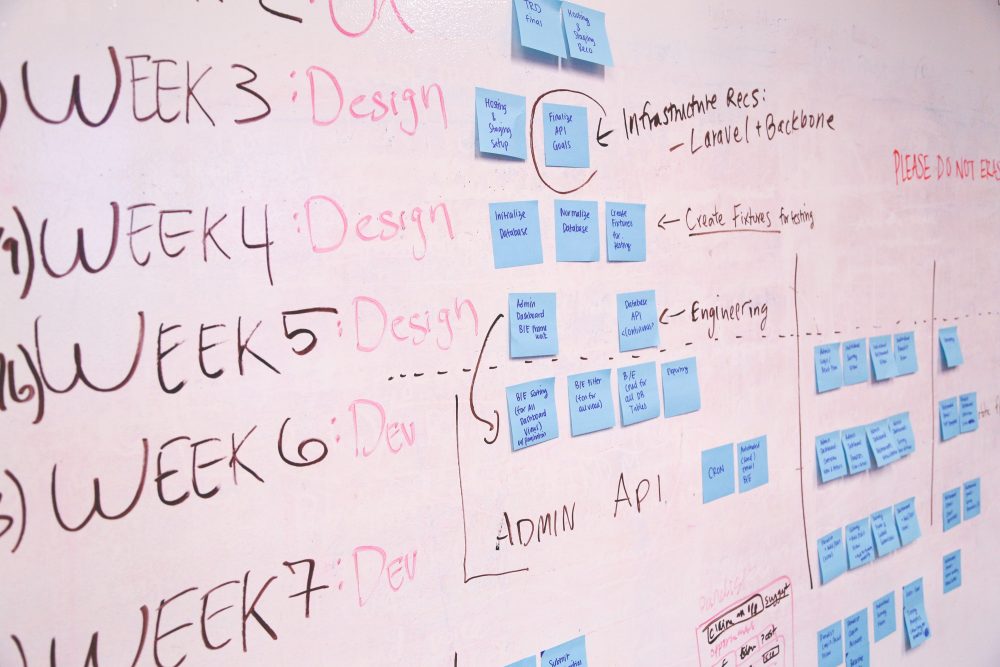Tim Stringer is not afraid of embracing new technology. In fact, he is so good at it that he started a business designed to help people use technology to their best advantage. This business, Technically Simple, teaches people, among other things, how to best apply the tool OmniFocus – an app, which, simply put, helps you to get things done. Tim identified a niche in the market that he could fill with his specific set of skills and concentrated on doing just that – with great success. His business has been running since 2003, was completely restructured in 2009, and turned 15 in 2018, the same year WordPress celebrated its own 15 year anniversary. It is a great testament to finding your place in the marketplace and building your audience.
Carolyn: First of all, I just want to talk a little bit about your business. Please could you explain the concept behind Technically Simple for someone new to the idea?
Tim: I launched Technically Simple back in 2003. The mission of the company then, and still is, is to support people and organisations who would really benefit from technology. I think all too often, technology has become a source of stress in our lives, and I set out in my own way to rectify that, to show how technology can be used in very positive ways to relieve stress.
One of the pieces that grew out of Technically Simple is Learn OmniFocus – which focussed on a specific technology, and how to use it productively.

Carolyn: How did your involvement with OmniFocus help you on your journey as a new entrepreneur?
Tim: I started using OmniFocus in 2009, after reading David Allen’s Getting Things Done book (GTD). OmniFocus was really designed around Getting Things Done, and is a tool that helps to implement the GTD approach. When I first started using OmniFocus I wasn’t quite sure how to use it effectively or structure it. I went looking for some materials to further my learning. There was a really good book that was available at the time, so that definitely helped, but I found there wasn’t any course that I could go do, or training videos to watch, or things like that.
So I decided to create my own course. I offered it here in Vancouver, and I let the Omni Group know about it. The Omni Group are the company that develops OmniFocus. They said, Oh, can we send a couple of people to Vancouver to film your course and interview you? They’re just down the road in Seattle, so it wasn’t too far for them to travel.
So they came up for the day. I gave the course, and did a fun interview. That really helped put me on the map, in terms of somebody who had a keen interest in OmniFocus. That, combined with a talk I gave in San Francisco, led to inquiries from people all over the world, asking if I’d help them with their OmniFocus setups. So I started working with this international audience. I soon realised that there was no way I could possibly keep up with the demand, just as one person. I also found I was repeating things over and over again, and I thought it would be great to have some recordings of these things to point people to.
That’s where Learn OmniFocus was born – about four years ago. I didn’t really know what to expect. It’s a very niche site centred around a very specific software app for Mac and iOS. But much to my surprise, it’s really taken off over the years. I’ve got members in over 75 countries. I think 77 is the total, and it’s going stronger than ever today.
Carolyn: That’s amazing. You identified an opening that you could step into, and I think that’s very important as a new entrepreneur, to identify the niche that is there for you.
Tim: I think that’s where a lot of businesses fail – people try to be too broad. They try to appeal to everyone, and Technically Simple really took off when I got known for something very specific. And once I have people’s attention, there’s certainly a lot of other places I can take them.
Another piece to this is creating some buzz around the product before it launches. I think by the time Learn OmniFocus launched, I had about 1000 people on the mailing list, and I’d done some teasers ahead of time. So, it was about three or four months before the site actually launched that I was starting to build the anticipation around it. The day I launched the site, I had people signing up to be members.

Carolyn: Impressive! I’ve read that you trained as an engineer and that you’re also a yoga and meditation teacher. Those are some broad disciplines! I was just wondering how this background has helped you with what you do? Do you find you draw on all of those different disciplines?
Tim: Yeah, definitely. I graduated with a degree in electrical engineering, with a computer systems minor, back in 1990, and worked in the corporate world for 13 years. I found the corporate life could be pretty stressful, and that’s what motivated me to get into yoga, and I enjoyed it so much I became a certified yoga teacher in 1999.
All of that experience really is part of the work that I do today. I draw upon all of those different things. Part of it is understanding what life is like for someone who’s in the corporate world, because I’ve been there. I’ve been in the thick of it, and I know how unmanageable that can be. At one point I was getting about 500 emails a day, and managing a team of over 200 people. I was definitely working in the fast lane.
All of these different facets contribute to the work that I’m doing today. And collectively, I talk about them under the umbrella of what I call Holistic Productivity. That’s about looking at all aspects of life, and realising that you can’t focus on all areas of life at once. You need to be strategic about which is the one that really deserves attention. It could even be getting more sleep at night, or adding in a meditation process. Focusing on that one thing might actually make other things more effective at work, or make people more productive, because they’re more relaxed, and naturally focused.

Carolyn: You said you started back in 2003. It must have been quite a different landscape back then. Was it more difficult to get people to use new technology?
Tim: Things have changed dramatically over the years. Looking back to 2003, there was no Facebook or iPhone, or any of these things that are commonplace today. A lot of people didn’t even have websites, so that was something I supported people with in the early days – getting a website up and running. And certainly on the web-side of things, things were far more limited than they are today.
So it feels like in this day and age, I’ve got a lot more to work with. The technology has come so far. The apps and devices have developed dramatically. So it has the potential to be used in a very productive way. I think the downside is that there is so much noise out there now – so many social media services, and various things competing for people’s attention – that in some ways it’s more challenging to be productive today than it was when I first started the company.
I guess I would sum it up that some new challenges were born and some other ones disappeared.

Carolyn: That makes sense. In one of your webinars you talk about putting your business to one side in 2008 for health reasons. I was wondering if it was hard to pick it up again, after that, and how you re-built your customer base?
Tim: It turned out to be both the worst and the best thing that happened to me, all rolled into one. I basically had to put my company on hold during that time. I was very sick, and wasn’t sure if I’d even make it to Christmas that year. This is also when I listened to the audio version of the GTD book, and I actually applied that as part of my healing process. Fortunately, the story had a very happy ending. I had a clean bill of health by the end of the year. I had the choice of continuing my business the way I’d been running it, or to just start something new. I really had a blank canvas to draw on.
I decided to go with the latter. I reinvented the company. I was really inspired by what I’d read in GTD, and wanted to go down that route, and just took some time to explore that, and to see where it took me. If I had it to do over again, I think I would have made exactly the same decision.
Carolyn: That must have been such a difficult year for you, yet you clearly managed to rebuild your customer base after it. Do you track your membership, and keep statistics?
Tim: I do track that quite closely. There’s definitely room for improvement in that area, around retention and so forth. The nature of the company is that sometimes people move from OmniFocus to a different task manager, so they might not have a need for the service. Other times, people will maybe become a member for a few months, and get what they need, and then come back later and pick it up. There are some people who leave the site, but I find there’s also a lot who end up coming back at some point, either because they’ve come back to OmniFocus, or they’re ready to take it to the next level.
Having said that, from a business point of view, that’s the area that needs the most attention, in terms of focusing more on retention, and really checking in with members regularly, and seeing what they need, and those sorts of things.
Carolyn: I see you are often a guest speaker. Is that that a method to keep people engaged with the site?
Tim: I’m a big fan of podcasts, and so I’ve been on many podcasts over the years. I rarely turn down an opportunity to talk about what I’m up to in life and work. It’s gotten to the point where I don’t really need to do any formal marketing. Word of mouth through things like podcasts and articles, and The Omni Group themselves, will let people know about the work that I’m doing, so it’s nice that I don’t need to put a lot of energy into the marketing side of things. It’s a self-sustaining, organically growing business.
Carolyn: Is there a sense of community around your work? Do your members engage with each other?
Tim: Yeah, definitely. One of the things that I wanted to offer to make it distinct from some of the other things that are out there, is to have live sessions each month. Sometimes they’re based around a specific theme, like we might talk about using OmniFocus in the team setting, or using OmniFocus with the calendar. Sometimes we have a workflow guest who will talk about how they use it, and how they structure it, and so forth.
Then there’s also what’s called Learn OmniFocus Office Hours, which are small sessions with up to 10 people that are video conferenced, and people are asked to keep things confidential. They can come and share their challenges, and what’s working for them, what’s not working as well as they’d like, and get advice both from me, and from other people in the session.

Carolyn: Brilliant. That’s very nice. That leads me into another question – you’re emphasising the importance of a supportive online community for OmniFocus, but who did you turn to for support as a new entrepreneur?
Tim: Who supports me? Well, I’ve worked with coaches. I’m trained as a coach myself, and I’ve worked with coaches for many, many years now, so that definitely helps. I’ve also been part of a Mastermind group that’s been really instrumental in, not just in getting advice from my peers, but in keeping me motivated and on track, and bringing an accountability piece.
I think just in general, using social networks like Twitter, to connect with other people who are doing similar sorts of work, where possible, and making a point of actually meeting them in person, starting to form a relationship.
Carolyn: I read that you were doing your own customer support and testing your own website. Is it still just you, or have you got more people to help you now?
Tim: It’s largely just me. The support side of things, fortunately, has been pretty minimal, so that hasn’t proved to be a major challenge. I definitely want to grow the team – have people creating and editing content, and also some admin support as the number of members starts to grow.
I try to use automation where possible, and when people contact customer support, I send quite a detailed email to let them know when they can expect to hear from someone. I put a few commonly asked questions in the automatic response, and so forth. In some cases, that might answer someone’s question before I even email them back. So that’s definitely helped.
I think with that, it’s really important to manage expectations. If people are expecting a response within an hour, and the best I can promise is a couple of business days, it’s better to just let people know that up front. I think just getting something back, even if it’s an automated email with some links to learn more information, helps resolve the problem, and maybe even gives people the information they need.
Carolyn: What made you choose to use WooCommerce in the first place? Were you familiar with it? Were you considering other options?
Tim: I did a lot of research into various options. WooCommerce really stood out as the one that was going places, and was going to be around for many years to come. I think that’s an important consideration when doing any sort of an online business – is this technology going to continue to be supported and updated indefinitely? Because the cost of switching to a new eCommerce system would have been very pricey. I’m very happy I went with WooCommerce. It’s really served me well over the years, and there’s even more momentum behind it than I could have imagined. It’s amazing how the presence has grown, especially after being acquired by Automattic. I feel totally confident that it’s going to be around for a very long time.
Carolyn: Are you still using both PayPal and Stripe as your payment methods?
Tim: Yes. My preference would have been to go with only Stripe, but the reality is, there’s a lot of people with PayPal accounts that haven’t even heard of Stripe, and they want to be able to just log in to their PayPal account, and subscribe that way. That continues to be the case to this day, so I support both of those, and I don’t see that changing any time soon.
Carolyn: And did you find it difficult to come up with the pricing model for the subscriptions? I see you have three tiers on your website.
Tim: Yeah. I gave that a lot of thought. Pricing can be a really tricky piece. I did do a survey, just to get a taste of what people would pay. Would they even pay anything for this, because there is so much free content on places like YouTube? That survey gave me some really useful data. I ended up going with three options. A three month, six month, and one year option. People get the most value, the lowest price per month, if they go for the annual option.

If I went back, I don’t think I would change it by a penny. It’s just worked out really well. It’s high enough that people will take it seriously, and value it, but it’s not so high that it becomes a major decision about, Should I sign up for this or not?
Carolyn: Obviously you chose to use the subscriptions plugin . Could you just quickly explain how you find that helpful for your site?
Tim: The subscriptions plugin is another one that I felt had a very strong future. When I first started using it, it was quite robust, feature-rich, and it’s come a long way over the past four-plus years, and evolved into a very mature product, with a lot of configurability, and things like that.
With that combined with WooCommerce, I feel like I’ve got a really solid platform.
Carolyn: Are there any other plugins that you use on the website, or in WooCommerce, that you would recommend to someone who was starting out, as useful tools?
Tim: As a general rule, I would recommend against any custom development, unless it’s absolutely necessary, because once you have something custom built, you’re probably paying a developer to get support for it. You don’t have all the tech support you would get with the WooCommerce plugins that are sold by WooCommerce. It could get quite expensive, putting development into it, to support changes in the future, as WooCommerce itself and WooCommerce Subscriptions evolve as well.
Carolyn: Are there are any pitfalls that you fell into as you were starting out, that you would advise a new entrepreneur to avoid?
Tim: No. I was fortunate in that there was such a strong demand for what I had to offer that Learn OmniFocus was pretty much an overnight success.
I think probably the biggest challenge was getting used to the technology, and there were some issues with things like Follow-Ups, in the early days. Fortunately that’s really worked itself out over the years. I’ve really noticed how much more mature WooCommerce and the plugins have gotten over time.
So with somebody starting out today, I think they’re building off something that has had many years of development, and testing, and bug fixing, and things like that. The time I took it on, it was at an earlier stage, and there were some hurdles. But I stuck with it, and overall, it’s worked really well.
Carolyn: So what would be next for Technically Simple?
Tim: Technically Simple is essentially the mother of Learn OmniFocus, and I’m looking at some possible offshoots of that. In general, just continuing to blog about how to use technology effectively, beyond just using OmniFocus and things that would apply to people on other platforms, and so forth. So I don’t have any official announcements around that yet, but I certainly have no shortage of ideas.

I'm also looking at the possibility of bringing it into other languages, French, Spanish, and German would be first on the list; to accommodate those who aren't English first language speakers that might find it a bit hard to follow sometimes, and also just to open it up to even more people. I'm sure there's still quite a big untapped market out there.
Another thing is growing the team. That's going to be a major focus for next year. I do work with some contractors, but I'm essentially a one person company, and that's really where I've hit the limit in some ways. To really do everything that I want to do, I really need to have a team that I work with.
Carolyn: Do you have any advice to offer anyone who is starting a WooCommerce business for the first time? You've been doing it for a long time now, so what would be your recommendations?
Tim: I guess it would largely depend on their circumstances. I think that the best way to approach this can be working full-time and doing it on the side. There's a really good book called, Overlap, which is perfect for people who are just kind of dipping their toes into entrepreneurship, or maybe they have an existing company, and they’re thinking of transitioning it to another area. The idea is you build up the new thing while you’re still doing the old thing, so the new thing doesn’t have that pressure to earn money and to be successful right out of the gates.
It’s nice to still be able to pay the bills while starting a new WooCommerce initiative. I also think, regardless of what kind of business it is, it can be very useful to start to get known for that area, be an expert in that, contribute things that are of value without there being a price tag associated with it. Essentially, provide some content, advice, that is going to serve the community, whether or not they become customers. And I think that’s a great way to build a following, and once the doors open to the WooCommerce store, once that’s expanded, people will be eager to partake.
Conclusion
Technology has certainly changed a lot since 2003, when we were tapping away on our Nokia phones and anything more than a MySpace page seemed like pure fantasy. Tim has guided people on their technological journeys for over 15 years – amid an ever-changing world. As we rely more and more on technology to organise our lives, Technically Simple has provided invaluable support, focussing on OmniFocus and on building a community based around its concepts. Tim has found a dedicated and growing customer base by concentrating on his niche and keeping the complexities of productivity training “technically simple”.

